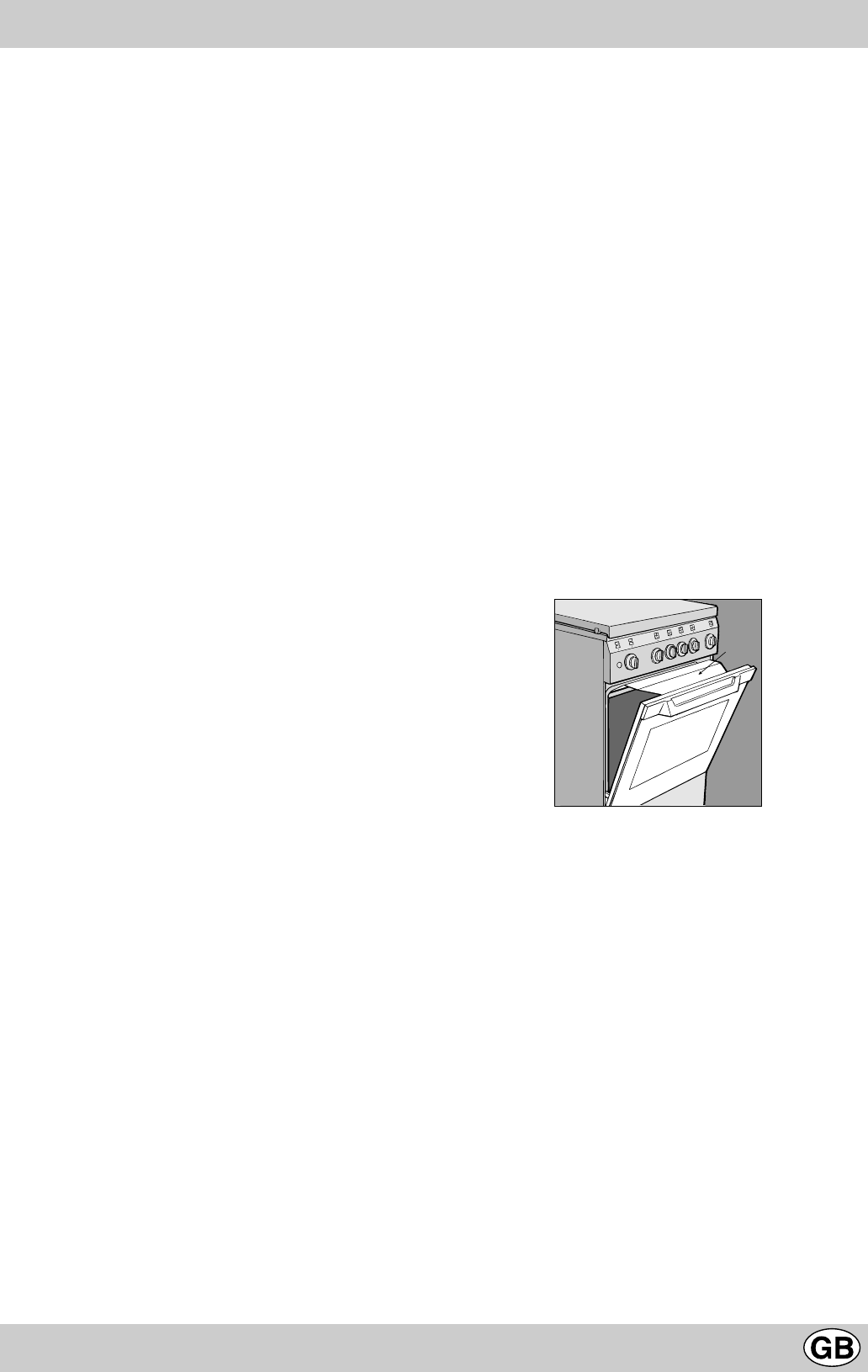
7
The different functions and uses of the oven
The various functions included in the cooker are selected by
operating the control devices located on the cooker control
panel.
Notice: The first time you use your appliance, we recom-
mend that you set the thermostat to the highest setting
and leave the oven on for about half an hour with nothing
in it, with the oven door shut. Then, open the oven door
and let the room air. The odour that is often detected dur-
ing this initial use is due to the evaporation of substances
used to protect the oven during storage and until it is in-
stalled.
Attention: Only use the bottom shelf of the oven when using
the rotisserie to cook (where present). For all other types of
cooking, never use the bottom shelf and never place anything
on the bottom of the oven when it is in operation because
this could damage the enamel. Always place your cookware
(dishes, aluminium foil, etc. etc.) on the grate provided with
the appliance inserted especially along the oven guides.
The oven knobs
With these two controls you can select the different
functions of the oven and choose the cooking temperatu-
re suitable for the food you are preparing. The different
cooking functions are set up by operating the two knobs:
G - the selection knob
N - the thermostat knob
on the oven panel.
For any selection-knob setting different from idle, identified
by the “0”, the oven light turns on; the knob setting marked
8
permits turning on the oven light without any heating
element being switched on. When the oven light is on, it
means that the oven is in use, and it will remain on for the
entire time the oven is being used.
1. Static oven
- Knob “G” setting: a
- Knob “N” setting: anywhere between 50°C and Max
The oven light turns on and the top and bottom heating
elements (resistors) switch on. The temperature, fixed by
the thermostat knob, is reached automatically and kept
constant by the thermostat control. This function permits
cooking and type of food thanks to excellent temperature
distribution.
2. The bottom heating element
- Knob “G” setting: y
- Knob “N” setting: anywhere between 50°C and Max
The oven light turns on and so does the bottom heating
element. The temperature, fixed by the thermostat knob,
is reached automatically and kept constant. This setting is
recommended for finishing the cooking of foods (placed
in pans) that are well done on the outside but still not done
inside or for desserts covered with fruit or jam which require
a light browning on top. Note that this function does not
permit reaching the maximum (250°C) temperature inside
for cooking foods always on this oven setting unless the
foods are cakes which only require temperatures below
or equal to 180°C.
3. The grill
- Knob “G” setting: F
- Knob “N” setting: Max
The oven light turns on and so does the infra-red ray grill.
The rather high and direct temperature of the grill permits
browning the outside of meats immediately thus keeping
in the juices and assuring tenderness.
4. The double grill
- Knob “G” setting: d
- Knob “N” setting: Max
The oven light turns on and so does the double heating
element of the grill. This grill is larger than the average
and has a completely new design: cooking performance
is increased 50%. The double grill makes sure that even
the corners are touched by heat.
Important: when using the grill, keep the oven door closed
to obtain the best results and save energy (about 10%).
When utilizing the grill, place the rack at the lower levels
(see cooking table). To catch grease or fat and prevent
smoke, place a dripping-pan at the bottom rack level.
Important: when using the grill, the oven door must be
left partly open by positioning the deflector “D” between
door and panel to prevent the cooker knobs from
overheating.
The oven-operating pilot lamp (L)
Signals when the oven is heating. It switches off when the
temperature inside the oven reached the temperature
selected by the knob. At this point the alternate turning on
and turning off of this light indicates that the thermostat is
operating correctly to keep the oven temperature constant.
The cook-top electric plate control knobs (I)
The cookers may be equipped with standard, fast and
automatic electric plates in various combinations (the fast
plates distinguished from the others by a red dot in the
centre, the automatic ones by a round aluminium disk at
the centre.
To avoid heat dispersion and damage to the plates,
recommend using cooking vessels with flat bottoms in
diameters which are not smaller than the plate diameter.
Table shows the correspondence between the position
indicated on the knobs and the use for which the plates
advised.
D














